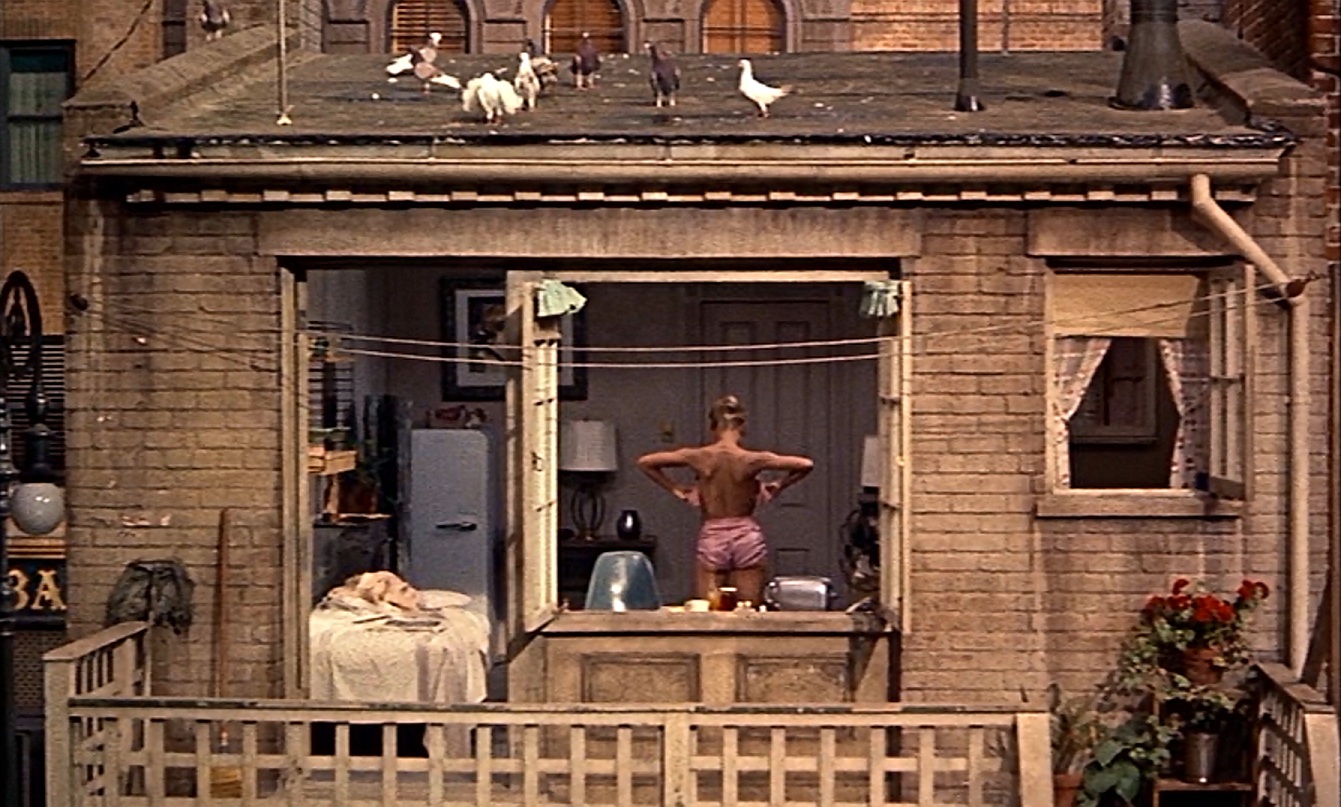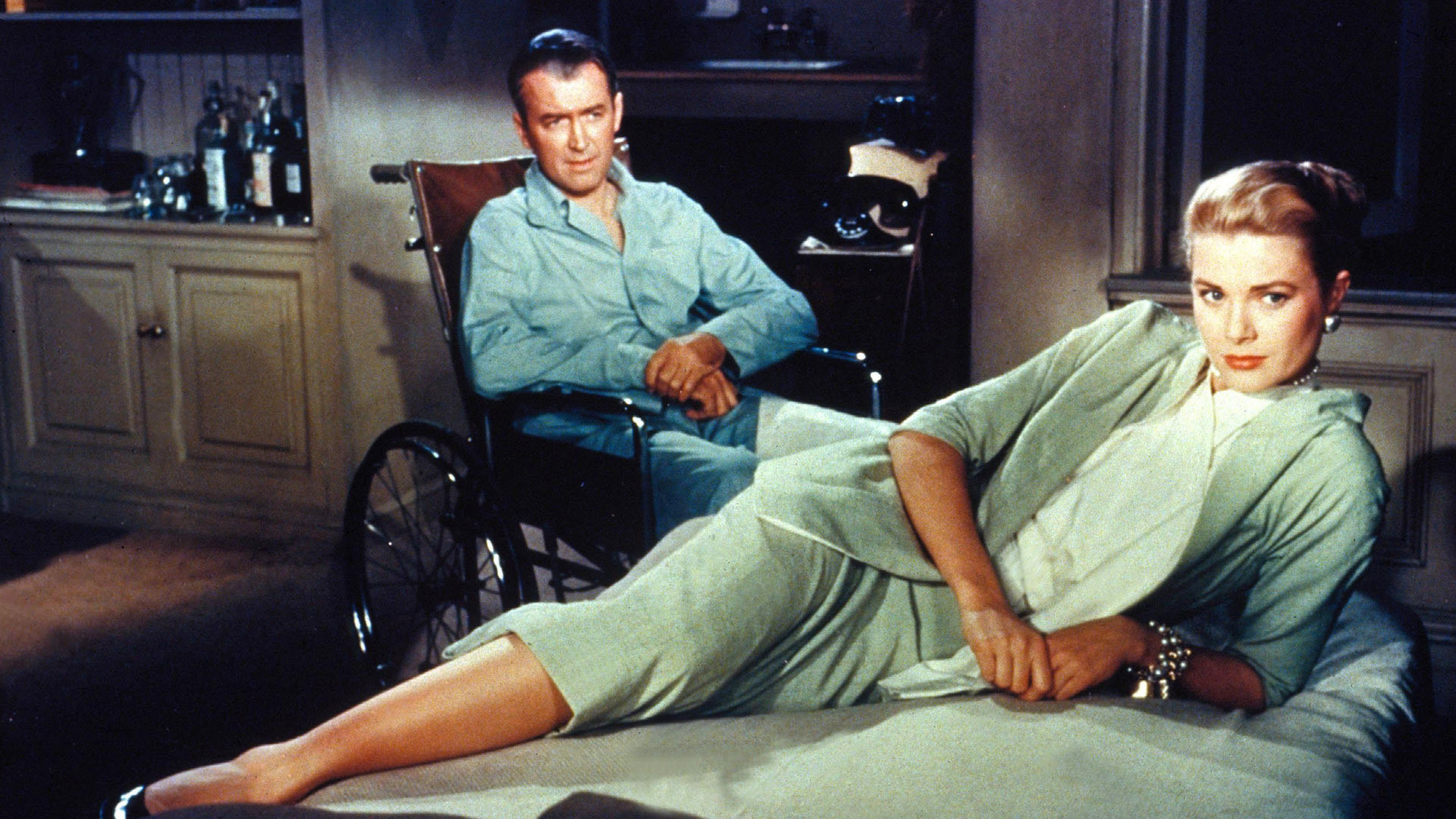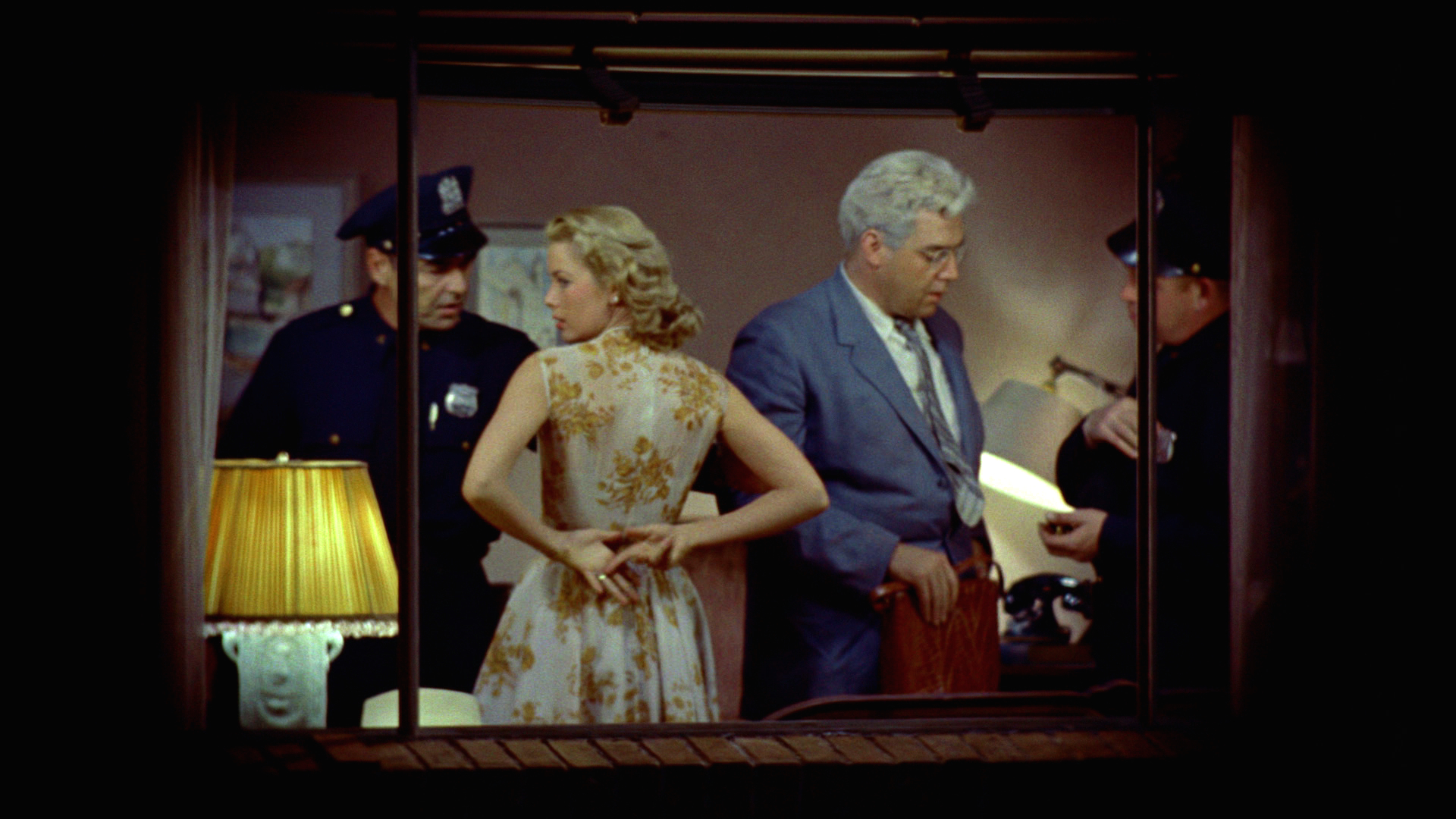“That’s a secret private world you’re looking into out there. People do a lot of things in private they couldn’t possibly explain in public.”—Rear Window (1954)
“I can’t figure out if you’re a detective or a pervert.”—Blue Velvet (1986)
August is Alfred Hitchcock’s birth month, and an occasion for cinephiles to mull the director’s accomplishments and controversies. Meanwhile, September marks the thirtieth anniversary of the release of David Lynch’s Blue Velvet, the film that introduced its creator to the cult-minded public as he’s known today—as a purveyor of obsessive and emotionally desolate pop surrealism, which takes among its inspirations the melodrama of soap operas and the symbolism of many films, including those of Hitchcock. Linking Hitchcock and Lynch together as compatible artists isn’t new, of course. Take, most obviously, the fashions in which Vertigo and Mulholland Dr. have been discussed in tandem as mysteries exploring romantic loss and malleable identity. A relationship also exists between Rear Window and Blue Velvet, which would make for an ideal double feature.
Rear Window and Blue Velvet epitomize an obsession long nursed by their respective creators: with the private worlds that exist underneath public facades, unknowable, except at potentially great cost. Both films feature protagonists who appoint themselves amateur sleuths, risking the lives of themselves and their loved ones so that they may know something. Hitchcock and Lynch are unsentimental about their heroes’ motives, portraying their characters less as do-gooders than as disturbed men with sexual hang-ups that require the exorcism of intrusion into the realms of others. Both films are headlined by virile white men recently rendered vulnerable by catastrophe, and both films show said men to be lured into other worlds by fear as well as by the promise of carnal knowledge of forbidden women. This forbidden-ness is contrasted with a known sexual dimension that both men enjoy and take for granted. In each film, this known sexual entity, a Girl Friday, is a gorgeous blonde, which might perhaps spark a note of resentment in the truly sexually frustrated sitting among the audience.

Rear Window’s L.B. “Jeff” Jefferies (James Stewart) is an acclaimed photographer laid up for six weeks with a broken leg that he suffered due to idealism and recklessness, as Hitchcock establishes beautifully and wordlessly with a few photographs judiciously placed in L.B.’s urban apartment. Blue Velvet’s hero is also a Jeff, Jeffrey Beaumont (Kyle MacLachlan), a college student at home in the small town of Lumberton to see his father, who suffers a stroke in a gorgeous and terrifying opening that contrasts the ludicrously idealized Peyton Place-ish exterior of the town with the bugs festering in the Beaumonts’ front yard. The insects are presented in close-ups that liken them to monstrous giants, establishing a contrast of polite and hidden society.
L.B. and Jeffrey are both charismatic, good-looking, intelligent men probably accustomed to getting what they want, but they’re beginning to feel hemmed in by their societies. L.B. has a problem many people wouldn’t consider as such: a socialite, Lisa Fremont (Grace Kelly), wants to tame and marry him, landing him more profitable and less dangerous assignments. Money, potential love, and probably pretty good sex—all unceremoniously dropped at L.B.’s front door in a tidy package. But this possibility represents for L.B. a loss of control and potentially a kind of emasculation, embodied by the broken leg that protrudes from his wheelchair like a comic, contextually useless erection. Jeffrey, meanwhile, is brought into crisis by his father’s emasculation, visiting the incapacitated man in the hospital, as Lynch lingers on the patient’s face, distorting it to suggest that Jeffrey is both afraid and resentful of his father’s fragility. Though younger than L.B., Jeffrey also understands the loss of control.

In both films, the thriller elements represent funhouse distortions of the protagonists’ fantasies and anxieties. Rear Window is a famously one-set film, taking place in an elaborately cramped city courtyard, which we see primarily from the rear window of L.B.’s apartment, overlooking the habitat from above. Through his voyeurism, we’re vividly acquainted with several neighbors: “Miss Torso” (Georgine Darcy), an exceptionally fit and shapely ballet dancer, who entertains constant male admirers (including, unbeknownst to herself, L.B.); “Miss Lonelyhearts” (Judith Evelyn), who, as her L.B.-assigned nickname suggests, has the opposite problem of Miss Torso; a newlywed couple (Rand Harper and Havis Davenport), whose marriage quickly appears to crumble; a pianist/songwriter (Ross Bagdasarian), who inadvertently scores the film’s emotional crescendos; a couple on the fire escape (Frank Cady and Sara Berner); and, of course, the primary objects of L.B.’s surveillance, Lars and Emma Thorwald (Raymond Burr and Irene Winston), the former eventually suspected by L.B. of murdering the latter. What all of these people offer L.B. is a tapestry of the benefits and perils of marriage, and imagined preview of what settling or not settling down with Lisa could mean, for both better and worse.
It’s indicative of Hitchcock’s brilliance that we feel we know this neighborhood, coming to share L.B.’s egotism. We certainly know it geographically, as Hitchcock establishes the setting with a casual sense of spatial mastery that should be the envy of most directors. We know little about L.B.’s neighbors emotionally, though, because we share L.B.’s presumptions. We empathize with Miss Lonelyhearts’ misery, for instance, particularly as she heartbreakingly playacts an imaginary date, but, upon retrospective consideration, what do we actually know about her? What events led to her social estrangement? Similar mysteries haunt the other residents, though L.B. doesn’t respect the power of this cumulative unknown, because he’s diverting himself from his own insecurities, pronouncedly about the class differences existing between him and the well-to-do Lisa. L.B. regards this neighborhood—which, from his vantage point, resembles the underground portion of an anthill from a distance, with its various tunnels and chambers—and presumes to play leader. He anoints himself a detective in a manner that, as many have observed, resembles the role of a movie audience member, and, as L.B. begins using a telephoto lens to gain greater vision, that of a filmmaker.

L.B.’s rear window is a portal into the world that exists around him, while Jeffrey’s portal into Lumberton’s nether-dimensions is a detached human ear. Lynch isn’t subtle with this symbolism: Near the beginning of the film, he pushes closer and closer into the ear, allowing us to regard its internal contours as a spiral, or even as a seashell. The aural textures suggest an echoing, roiling ocean—an undertow of something great, powerful, and primordial. At the end of the film, Lynch dollies out and away from the ear, suggesting an exit from the underworld, which Jeffrey has managed to leave remarkably not all too worse for wear.

Like L.B., Jeffrey wants to know about his neighbors, and this desire enmeshes him in a whodunit. L.B. has to look for the murder mystery that he finds, but a severed ear has a way of dropping the macabre on your doorstep. To learn more, Jeffrey develops a flirtation with a policeman’s daughter, Sandy (Laura Dern), who, like Lisa, offers her man a preview of a more influential world. (Tellingly, Lisa and Sandy are even introduced in similar manners, both in rapturous slow-motion, each emerging from Somewhere Else, which is to say from outside of the hero’s increasingly internal purview.) She might only be a cop’s daughter, but that presumably trumps a hardware man’s son in the small-town caste system. Even if it doesn’t, Sandy has the power of overhearing what her father says about the ear, and this leads Jeffrey to the tarnished lounge singer Dorothy Vallens (Isabella Rossellini).
If Rear Window is a comedy of marriage, physicalizing a man’s internal journey of accepting a woman’s proposal (itself a form of emasculation), then Blue Velvet is a coming-of-age tale. The latter follows Jeffrey as he works through his first journey into the adult world, surviving its high-stakes dangers and the intoxicating promise of higher-stakes rewards, such as sex with Dorothy, a damaged older woman who suggests a bolder, sexier, kinkier Miss Lonelyhearts. Unlike L.B., Jeffrey satiates the sexual curiosities that drive him toward his neighbors’ personal spaces; like L.B., Jeffrey first must assume a passive observational role that deliberately suggests film-going.
In Blue Velvet’s most powerful and notorious scene, Jeffrey observes his quarry while hidden, like L.B.; only he’s more dangerously positioned in the world of his subject of interest. Hiding in a closet in Dorothy’s expressionistically seamy apartment (which has the same soft, edge-less womb resemblances that later characterized the “red room” of Lynch’s Twin Peaks), Jeffrey watches while the film’s villain, Frank (Dennis Hopper), rapes her, playacting an incestuous fantasy that involves stuffing the belt of her blue velvet bathrobe into each party’s mouth (and posing it to resemble an umbilical cord, as Robin Wood has observed). Jeffrey already has spied on Dorothy once, and she caught him and initiated a kind of rape-associated foreplay that retrospectively suggests she’s asserting the same power over Jeffrey that Frank asserts over her. Jeffrey’s intensely turned on by Dorothy’s life, including her unimaginable imprisonment and torture at the hands of Frank and his goons, in scenes sometimes staged by Lynch as perverse comedy. Jeffrey can’t admit this about himself, so he plays the role of savior.
Which is what L.B. also does. L.B. can’t entirely admit to feeling titillated by the possibility of Lars killing his wife; L.B.’s investigative crusade serves as a substitute for the dangerous and implicitly sex-related photography assignments he’s temporarily unable to accept. L.B. favors his job over Lisa because it contains associations of machismo, violence, and extremity that find their expression in the murder mystery across the courtyard; Lisa’s gameness in the mystery proves to L.B. that he can potentially have some kink along with the domestic arrangement. Hitchcock detonates the idea of a dichotomy between rebellious adventure and the various social tethers of domestication: The film says there’s no such convenient either-or stricture, or needn’t be. It’s all mixed together. For all its garish, amazingly lurid energy and formal inventiveness, Blue Velvet aren’t as thematically sophisticated as Rear Window, for it insists—with a naiveté so pointed it almost has to be purposefully ironic—that bad exists underneath all of good, but that good can somehow gain supremacy anyway.

Ultimately, both films are driven by a similar, peculiarly immersive energy, derived from letting the heroes observe their own narratives. L.B. and Jeffrey aren’t just protagonists; they’re viewers, watching and gasping along with us. The strongest images in each film represent a decisive break from our kinship with the heroes and our implied complicity with them as fellow consumers of cinema. In both films, these complacency-shattering images are close-ups of faces that we’ve previously regarded from a distance, through, respectively, the movie-screen-like scrims of a rear window and a shuttered closet door.
In Rear Window, when a neighbor’s dog is killed, Hitchcock briefly cuts to a close-up of Miss Torso, and then, a moment later, to a close-up of Miss Lonelyhearts. The effect of these shots is unmooring, forcing us to face the humanity of these women we’ve objectified and pitied from a remove throughout the narrative until now. In Blue Velvet, the image is also of a face, Dorothy’s, after Jeffrey hits her, as she reels back in pain and ecstasy. Especially with its emphasis on her blue eyeshadow and lush red lipstick, the moment is intensely erotic—but one is ashamed to find it so, as here Dorothy’s torment comes fully to the forefront of the film, revealing her operatic sense of hopelessness, of loss of identity and control. It’s in these moments that Hitchcock and Lynch confront the empathetic perils of their creative methods, attempting to redress the innate myopia of their masterful control. In these films and many others, Hitchcock and Lynch both burrow into the emotional chasms of singular heroes, but they also wish to transcend the self-obsession inherent in that aim. It is this irreconcilable desire that unites them.




